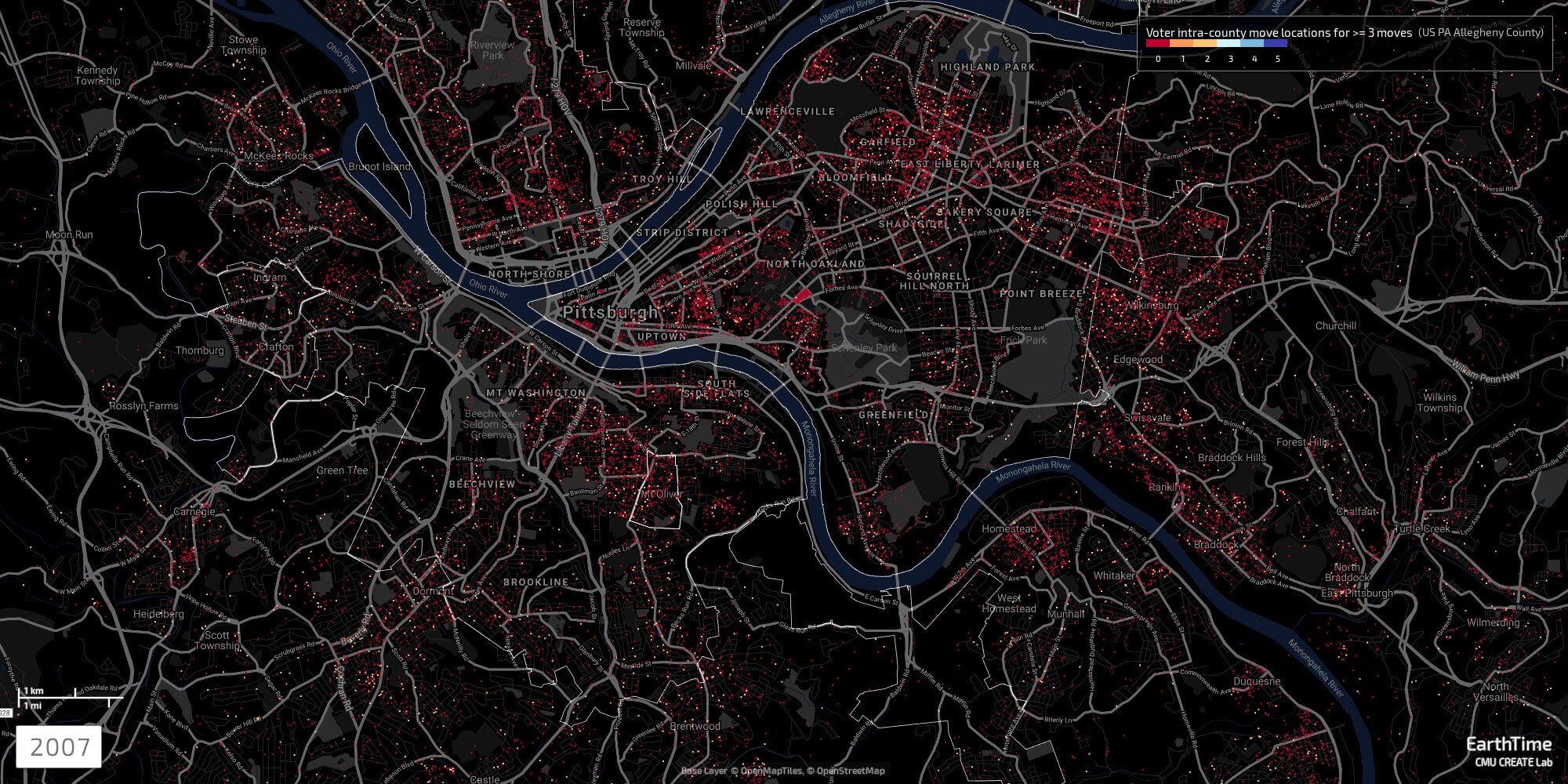
For the sixth consecutive year, Carnegie Mellon University's EarthTime platform will help leaders at the World Economic Forum meeting in Davos, Switzerland, visualize data on global challenges such as climate change, poverty and mental health.
It's a unique map-based tool that's proven popular at the annual meeting, helping experts from institutions worldwide present data in a way that makes their subjects and viewpoints clearer and more compelling. Presenters and audiences both appreciate the ability to zoom in on locales of interest to explore how physical and social forces are affecting people and the environment.
But staff members of the Robotics Institute's CREATE Lab, where EarthTime was developed and continues to be enhanced and fine-tuned, know that EarthTime can be just as influential when it takes a narrower, more intimate view of the world. At home in Pittsburgh, they're using it to ask questions about a subject critical to all—housing.
Most of the available housing data is of relatively recent vintage—since 1990— but project scientist Anne Wright says a much older document—a 1937 redlining map of Pittsburgh—continues to illuminate today's housing issues. Though redlining is illegal today, the outlines of those old redlined areas that banks considered too risky for housing loans match up well to today's areas of concern: neighborhoods where home values and median incomes are low.
"For me, the biggest insight I've had because of EarthTime is that data becomes undeniable when we map it out," said Megan Stanley, executive director of the Pittsburgh Commission on Human Relations. "One example is the legacy of redlining in Pittsburgh. We all agree that this is a terrible practice, but we talk about it like it happened in the distant past. However, when you look at housing value and mortgage acceptance rates today you see that the legacy of racism in housing still exists and affects a huge portion of the population."
Indeed, these relationships to historic redlining become obvious when Wright uses EarthTime to display 2007-2017 data available through the Housing Mortgage Disclosure Act.
"The vast majority of mortgage applications in those areas are denied," Wright observed, pointing out a swath of pink on the map. African-Americans receive far more denials than do their white counterparts, she added. Locked out of purchasing, many families in these areas are subject to "milking"—landlords who buy up wornout homes and apartments and charge as much rent as they can while avoiding repairs and other expenses.
Time-lapse images deepen the story, as the disappearance of public housing units is accompanied by a rise in rents. A time-lapse of evictions from 2000 to 2016 shows a swirl of dots between many of these neighborhoods, with each dot representing a family, Wright noted. EarthTime shows many of these moves are across school district boundaries. That, she added, suggests regular disruptions for many school children.
"EarthTime helps connect the dots," Wright said. "You may know what's happening to you and your family, but here we see what's happening overall."
In some of those formerly red-lined areas, a different phenomenon—gentrification—is at work. For instance, in Downtown and resurgent neighborhoods such as Lawrenceville and East Liberty, an influx of white, highly educated residents is displacing black residents, the EarthTime maps show.
"I think a big part of the story is who is moving where and what's going on in the places they're moving to," Wright said.
Here's where Wright and her colleagues admit they need better data. Presumably, many of the whites moving in are from places other than Pittsburgh, "but there's no way of knowing that now," she said. Perhaps more importantly, it's not yet clear where displaced low-income residents are going.
"There is some movement into Allegheny County, especially McKeesport," Wright observed from the EarthTime maps. Generally, those moving into the county can expect less access to mass transit and other services. "But the movement we're seeing isn't enough to explain what we're seeing in terms of displacement. Those people are going somewhere, but we don't know where."
With support from the Heinz Endowments and the City of Pittsburgh, the CREATE Lab has worked closely with the human rights commission on using EarthTime to study long-term housing trends. Stanley, the commission's executive director, said it has a way of bringing people together who might not otherwise think they have much in common.
"For example, neighborhoods that are separated by rivers and might not regularly interact may see that they are both struggling with issues of high eviction rates, or frequent movers, or concentrated poverty," she said. "I've never heard anyone say 'we were captured in the same dataset,' but I do see people coming together when they see the same issues in their communities mapped in EarthTime."
In Davos this year, EarthTime will be used to highlight mental health and green space, urbanization and, as usual, various aspects of climate change. As big and important as those topics might be, housing might be an even more significant use of EarthTime, said Gabriel O'Donnell, principal research programmer.
"Climate change is important, but yet nothing seems to happen from year to year," he explained. "Housing is where EarthTime has the potential for making a big impact."
Citation: Mapping a path to more equitable housing (2020, January 20) retrieved 20 January 2020 from https://techxplore.com/news/2020-01-path-equitable-housing.html
This document is subject to copyright. Apart from any fair dealing for the purpose of private study or research, no part may be reproduced without the written permission. The content is provided for information purposes only.
